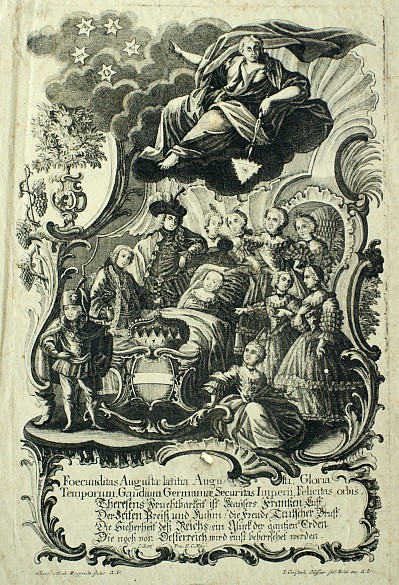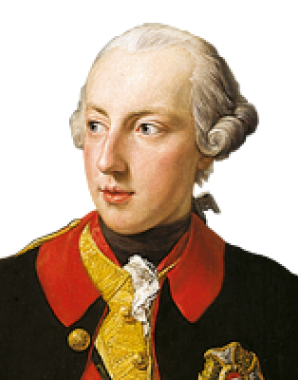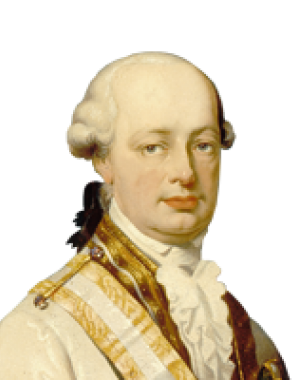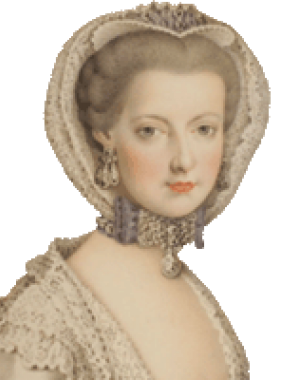Maria Theresa’s children
The fact that Maria Theresa gave birth to sixteen children is a well-known part of her life story. Of her eleven daughters and five sons ten survived into adulthood.
Maria Theresa’s first child, a daughter named Maria Elisabeth (1737–1740), died while still a young child. The eldest of the surviving children was Maria Anna (1738–1789), who developed strong intellectual interests and was very similar in character to her father. Afflicted by a deformation of the ribcage, she was not considered marriageable and remained with her mother until the latter’s death in 1780. Subsequently Maria Anna spent her remaining years as abbess of the St Elizabeth convent in Klagenfurt, to which she left her considerable estate.
The third daughter, Maria Karolina (b. 1740), died in infancy.
The arrival of Joseph (1741–1790) put an end to the long wait for a male heir. As emperor and successor to Maria Theresa and ruler of the Habsburg Monarchy he has his own biography on this website.
Maria Christina (1742–1798) was Maria Theresa’s favourite daughter but was not particularly popular with her siblings. She was the only child allowed to marry for love rather than political considerations. Her husband was Duke Albert of Saxe-Teschen (1738–1822), a non-ruling member of the widely ramified Saxon Wettin dynasty, whose mother was Archduchess Maria Josepha, a cousin of Maria Theresa, and who was thus fairly closely related to his bride.
According to contemporary accounts, Maria Elisabeth (1743–1808) was very pretty and thus chosen to play a leading role in her mother’s marriage schemes. However, her looks were destroyed by a bout of smallpox and she remained unmarried, later becoming rather eccentric and cantankerous.
The second boy Karl Joseph (1745–1761) was Maria Theresa’s favourite son: intelligent and charming, he was more likable than the rather withdrawn Crown Prince Joseph, with whom his relationship was one of fraternal rivalry. His early death at the age of just sixteen, when a smallpox epidemic carried off several members of the family, was a particularly heavy blow for his parents.
Maria Amalie (1746–1804) was married off to Duke Ferdinand of Parma against her express will as part of the rapprochement with the Bourbons. Determined and forceful, she never forgave her mother and their relationship remained cool for the rest of their days.
The third son Peter Leopold (1747–1792) initially had little chance of inheriting the throne. Following the early death of his brother Karl he became next in line to succeed his father as Grand Duke of Tuscany. When his elder brother Joseph II died without issue he became his successor on the imperial throne, an office that he held for only two years.
He was followed by two girls, who both died young: Maria Karoline, born in 1748, died shortly after birth, while Johanna, born in 1750, died from smallpox at the age of twelve.
Another smallpox victim was Maria Josepha (1751–1767), who died shortly before she was due to marry the Neapolitan crown prince.
Her place was taken by the next eldest daughter, Maria Karolina (1752–1814), who as controversial queen of Naples and Sicily would prove to be a true daughter of Maria Theresa. She was even more prolific than her mother, giving birth to a total of eighteen children.
Ferdinand Karl Anton (1754–1806) was a rather nondescript character. He married the heiress to the d’Este dynasty, which ruled over the northern Italian principality of Modena, and founded the collateral Habsburg-Modena line.
The best known daughter of Maria Theresa was Maria Antonia (1755–1793), who as Marie Antoinette would become queen of France and eventually meet her end under the blade of the guillotine.
Maximilian Franz (1756–1801), Maria Theresa’s youngest offspring, was a sickly child and thus destined for a career in the Church. He became archbishop and elector of Cologne, and was appointed Grand Master of the Teutonic Knights.
















